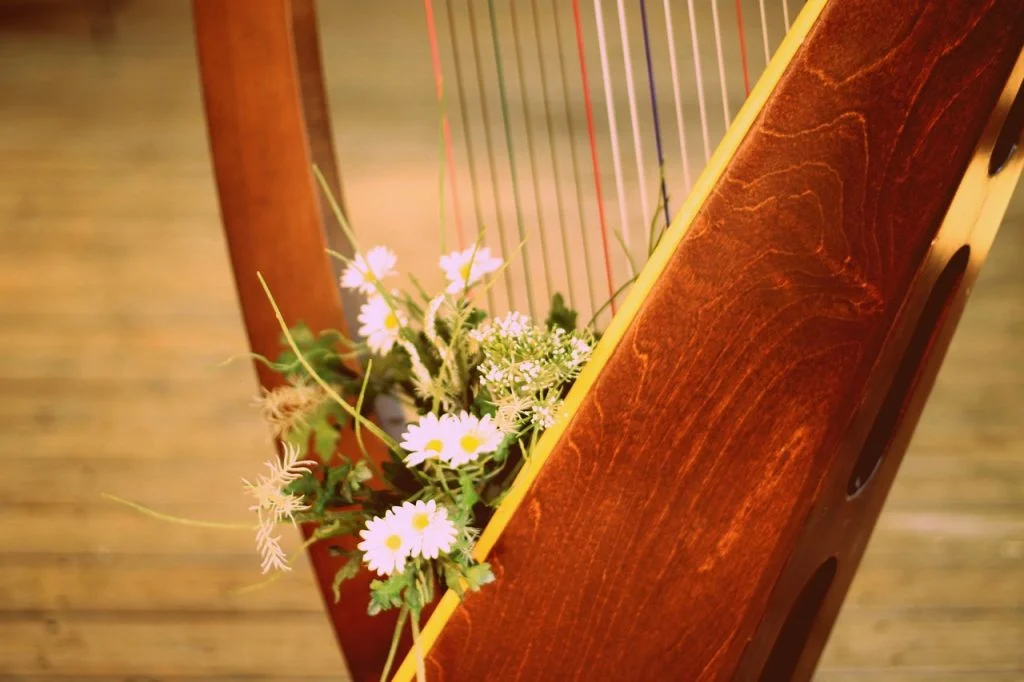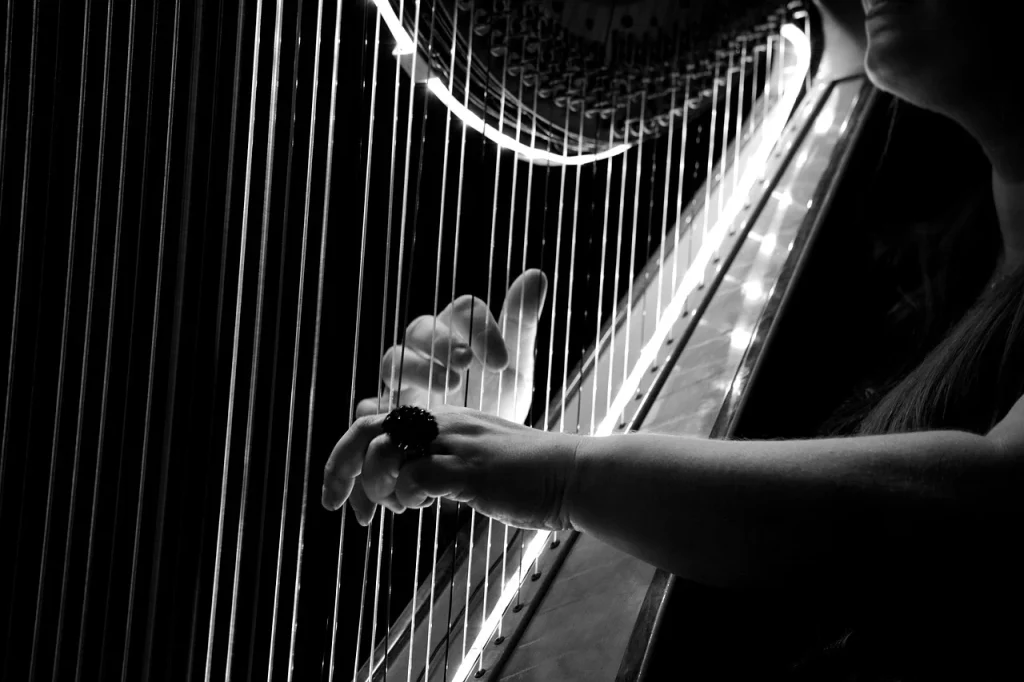Ever since my fingers first danced across the strings of a harp at the age of seven, I’ve been enchanted by its celestial sound. Do you remember the first time music truly touched your soul? For me, it was the harp’s melodic whisper, a blend of history and harmony, that captivated me.
Over the years, I’ve gathered a good chunk of experience with this magnificent instrument. From royal courts to quiet corners of monasteries, the harp has strummed its way through history. Let me take you on a journey through the 50 most intriguing harp facts, each one a string in the grand tapestry of its storied past.
Like a harp’s strings, life resonates with music sweet or sad.
Henrik Ibsen
Harp Facts
Step into the world of harmony with our facts about harps. Read attentively, as you’ll find a quiz at the end to test your newfound musical knowledge!
- Oldest Known Harp: The earliest harps were developed in Ancient Egypt around 3000 BC.
- String Materials: Harp strings were originally made from animal gut, commonly from sheep.
- Varying Sizes: Harps can range in size from small lap harps to large pedal harps over six feet tall.
- Symbolism: The harp is often associated with angels and heavenly music in various cultures.
- Pedal Harps: Modern pedal harps, invented in the 19th century, have seven pedals that change the pitch of the strings.
- Range of Strings: A full-sized concert harp typically has 47 strings.
- Irish Harp: The harp is a national symbol of Ireland, appearing on its coat of arms and Euro coins.
- Guinness Logo: The Guinness beer logo famously features a harp.
- Weight: A large concert grand harp can weigh around 80 pounds (36 kg).
- Cost: Professional harps can be as expensive as $100,000 or more.
- Electric Harps: Electric harps, which can be amplified, have become popular in contemporary music.
- Harps in Mythology: Harps are prominent in the mythologies of Celtic, Norse, and other cultures.
- Double Harps: Some harps have two rows of parallel strings, allowing for more complex music.

- Oldest Depictions: The earliest depictions of harps were found in Ancient Mesopotamia wall paintings.
- Orchestral Use: The harp became a regular part of the symphony orchestra in the 19th century.
- Levers: Lever harps, used in folk music, have levers at the top of each string for changing pitch.
- Playing Technique: Harpists typically use their first four fingers, omitting the little finger.
- Latin America: Harps have a strong presence in the traditional music of countries like Paraguay and Venezuela.
- Glissando: The sweeping motion across the strings is a signature harp technique called a glissando.
- Wire Strings: Some traditional harps, like the Scottish clarsach, use metal wire strings.
- Harpo Marx: Harpo Marx, of the Marx Brothers, was renowned for his comedic and skilled harp playing.
- Asian Variants: Asian countries have traditional harps, like the Japanese kugo and the Burmese saung.
- Harps in Africa: Various forms of harps are integral to the music of several African cultures.
- First Harp Concerto: Handel’s Harp Concerto in B flat (1736) is one of the earliest known harp concertos.
- Hand Position: The hand position for playing the harp is unique, with the wrists bent and fingers pointing downward.
- Therapeutic Use: The harp is used for its therapeutic qualities in music therapy sessions.
- Construction: Harps are typically made from wood, and the soundboard is often made of spruce.
- Portable Harps: Smaller, portable harps, like the Celtic harp, are popular among folk musicians.

- Amplification: Acoustic harps can be amplified using microphones or pickups for larger venues.
- Color Coding: On many harps, C strings are colored red and F strings are blue or black.
- Notation: Harp music is written on a grand staff, similar to piano music.
- Historic Harpists: Famous harpists include Marcel Grandjany and Carlos Salzedo.
- Transportation: Transporting a large harp often requires a special vehicle or harp trolley.
- Folk vs. Classical: Folk harps tend to be simpler in design compared to classical pedal harps.
- Range: The range of a concert harp is similar to that of a piano.
- Decoration: Harps are often elaborately decorated, especially historic and folk harps.
- String Tension: The tension of the strings on a large harp can total over 1,000 pounds.
- Harp Festivals: There are numerous harp festivals and competitions worldwide, celebrating harp music and culture.
- Resonance: The sound of a harp is produced by the resonance in the soundbox when strings are plucked.

- Multicultural Influence: The harp has influenced and been influenced by various musical traditions around the world.
- Learning Curve: Learning to play the harp can be challenging due to its unique technique and repertoire.
- Popular Music: The harp is increasingly used in a range of genres, including jazz, pop, and rock.
- Historical Evolution: The harp has evolved significantly over thousands of years in design and playing technique.
- Children’s Harps: There are smaller harps designed specifically for children to learn on.
- Unique String Order: Unlike most stringed instruments, the strings on a harp ascend in pitch as they get longer.
- Sound Variation: The sound of a harp can vary greatly depending on the materials and design.
- Symbol of Peace: In many cultures, the harp is seen as a symbol of peace and serenity.
- Harps in Art: The harp has been a popular subject in art and literature throughout history.
- String Replacement: Harpists often replace their strings regularly to maintain the best sound quality.
- Harp Therapy: Harp therapy programs train harpists to play in healthcare settings for therapeutic purposes.
Harp Myths

Having strummed through the facts, now it’s time to separate the myths from the actual truth about this instrument.
- Harps Are Only for Classical Music
Musicians use harps as versatile instruments in various music genres, including folk, jazz, pop, and even rock. Their unique sound adds a special touch to many types of music, not just classical. - Playing the Harp is Easy
While harps may appear straightforward, playing them well requires skill, practice, and dexterity. Like any instrument, mastering the harp involves learning complex finger movements and coordination. - Harps Have Always Had the Same Design
The design of harps has evolved significantly over centuries. From simple, ancient instruments with few strings to modern pedal harps with intricate mechanisms, their design has been refined to enhance musical capabilities. - Harps Are Primarily a Female Instrument
People of all genders play harps. Historically, many famous harpists have been male, and this stereotype is fading as more diverse musicians embrace the harp. - All Harps Are Enormous and Expensive
Harps come in various sizes and price ranges. While some concert grand harps are large and costly, there are also smaller, more affordable options like lever harps, suitable for beginners and casual players.
No products found.
Harp Quotes

While I was researching, I found so many quotes that it was hard to choose from. But here are my top five:
The harp at Nature’s advent strung has never ceased to play.
Alexander Pope
This quote by Alexander Pope, a renowned English poet, suggests that the harp’s music is as eternal and natural as the universe itself, continuously resonating since the dawn of time.
My fingers plucked the harp of life and made it sing.
George Eliot
George Eliot, a famous novelist, uses the harp metaphorically to express how she skillfully navigated and experienced the complexities of life, creating her own unique melody.
The harp is the traveler’s joy, a comfort to the distressed.
Thomas Gray
Thomas Gray, an English poet and scholar, highlights the harp as a source of joy and solace, especially for those who are traveling or experiencing hardship.
Give me a harp of truest tone and I shall move the world.
John Keats
John Keats, an iconic English Romantic poet, emphasizes the power of music, specifically the harp, to influence and transform the world when played with genuine emotion and skill.
A harp can sing of the present as well as of the past.
E.T.A. Hoffmann
E.T.A. Hoffmann, a German Romantic author, points out the harp’s ability to beautifully express both contemporary experiences and historical tales, bridging time through its melodies.
Harp FAQ

From the poetic strums of harp quotes, we now transition to the chords of the FAQ section. Let each question resonate with you, as they’re the keys to mastering the upcoming quiz.
- How much does a harp cost?
The cost of a harp can vary widely based on its type and quality. Small, beginner’s lever harps may start around $300 to $1,500, while larger pedal harps, often used by professionals, can range from $10,000 to $35,000 or more. The price depends on the craftsmanship, materials, and complexity of the instrument. - What are the different types of harps?
Harps come in mainly two types: lever harps and pedal harps. Lever harps, which are smaller and have levers to change the pitch of the strings, are great for beginners and folk music. Pedal harps, with foot-operated pedals to change pitches, are larger and commonly used in orchestras and for classical music. - How long does it take to learn the harp?
Learning the basics of the harp can take a few months, but mastering it is a lifelong journey. Regular practice is the key. Beginners might start to play simple tunes within a few weeks, but complex pieces and advanced techniques require years of dedicated practice. - How do you maintain and care for a harp?
Harps require regular tuning and should be kept in a stable environment, away from extreme temperatures and humidity. Dusting the harp regularly and using a soft, slightly damp cloth for cleaning is recommended. It’s also important to have professional maintenance and string replacement as needed. - Can the harp be played in different genres of music?
Absolutely! While people traditionally associate the harp with classical music, it’s quite versatile. Harpists play it in a wide range of genres, including folk, jazz, pop, and even rock. The instrument’s unique sound and range make it suitable for various musical styles.
No products found.
Harp Trivia

Welcome to the Harp Quiz! If you don’t strike the right chord with your answers, you might find yourself in a ‘harp’ situation, where every song you hear for the next week turns into a harp solo!
Conclusion
And that’s the lowdown on the high notes of harp history! We’ve journeyed through time, uncovering the harp’s majestic and, let’s admit, slightly peculiar past. It’s an instrument that’s both angelic and surprisingly sturdy – kind of like that one aunt at family reunions.
But here’s a thought: if harpists have ‘harp face‘ while playing, what face do you make when you’re deep in concentration? Go ahead, look in a mirror and give us your best ‘harp face‘ impression. Remember, in the world of harps, it’s all about being string-sational!
3 Sources Used For This Article5 Best Harps for Beginners of 2023 – American Song Writer
How Long Does It Take To Learn The Harp? – By The Barricade


